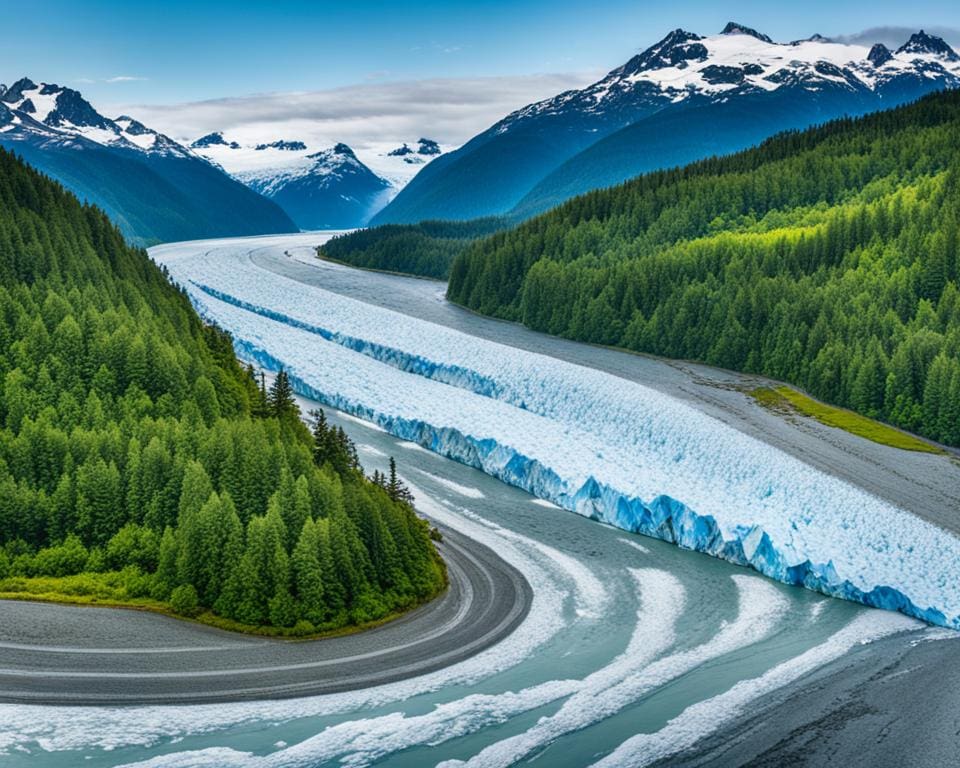Welcome to Juneau, Alaska’s beautiful capital. It was set up in 1881 during the gold rush and is stunning. Despite its small size, with fewer than 32,000 residents, Juneau offers wide-open spaces. It lies between mountains and the sea. This makes it only reachable by boat or plane, giving it a feel of a secluded haven.
Juneau is a place where you can see amazing wildlife. You might spot humpback whales or many brown bears on Admiralty Island. These sights aren’t just beautiful; they invite you to explore Juneau’s rich arts, music, and Native heritage. Every corner of Juneau reveals more natural beauty, proving Alaska’s landscape is truly breathtaking.
Discover the Unique Charm of Juneau, Alaska
Juneau, Alaska’s capital, pulls you in with its mix of history and stunning views. This city’s strong link to its roots shows the amazing stories of its people. Its beautiful setting also attracts those who love adventure.
The Rich History of Juneau
The Tlingit Indigenous people started Juneau’s story over 10,000 years ago. Their lasting heritage is key to the city, shown in places like the Sealaska Heritage Institute. Then, in 1880, Joe Juneau and Richard Harris found gold, sparking a rush. This turned Juneau into a busy place, full of life.
Because of its gold and good location, Juneau became the capital of Alaska in 1906. It was chosen for its close spots for mining and trading.
Geographical Significance
Juneau’s location is special. It’s tucked between ice-capped mountains, green rainforests, and the ocean waves of the Alexander Archipelago. Here, you can go hiking or kayaking. The city covers 3,255 square miles, making it one of the USA’s largest boroughs by land. Juneau is more than just a capital. It’s a place for discovery and beauty.

Juneau: Alaska’s Capital City and Its Natural Wonders
Juneau is a spectacular gateway to astonishing natural wonders. The iconic Mendenhall Glacier is at its heart, attracting adventurers and nature lovers. This glacier stretches over 13 miles. It showcases nature’s strength and elegance. This area has been home to Southeastern Alaskan Native cultures for more than 10,000 years.
Mendenhall Glacier: A Must-See Natural Wonder
The Mendenhall Glacier is vast and impressive. It spans a half-mile wide. Its ice depths vary from 300 to 1,800 feet. At the Mendenhall Glacier Visitor Center, you learn about its shrinking and how it’s part of the 1,500-square-mile Juneau Icefield. This area includes 38 major glaciers. Entry is $5, making it a top spot to visit in Juneau.
Outdoor Adventures Await
Juneau is full of outdoor fun, offering memorable experiences. Over 250 miles of trails wind through the Tongass National Forest. The Perseverance Trail and others offer stunning waterfall views. For marine adventures, whale watching excursions are available. You can see humpback whales and orcas from April to November.
Tours usually last 3 to 4 hours. This ensures a deep connection with these magnificent creatures.
In Juneau, you can hike beautiful trails or go on exciting whale watching trips. It’s a blend of nature and adventure. This city invites everyone to explore its rich wilderness.
Visitor Attractions in Historic Downtown Juneau
Historic downtown Juneau is a vibrant hub with many attractions that show the city’s rich history and unique culture. You can find it along South Franklin Street. There are charming shops, inviting galleries, and eat-out places that make it a must-see in Juneau. Notable spots include the iconic Alaska State Capitol and the Red Dog Saloon. The saloon dates back to the gold rush, bringing a nostalgic vibe.
A trip to Juneau is incomplete without checking out the Juneau-Douglas City Museum. This place offers insight into the capital city’s history and culture. With interactive exhibits and walking tours, visitors get a full view of the area. It talks about its original people and the variety in buildings. This historic downtown is also listed on the National Register of Historic Places, showing its importance to locals and visitors alike.
If you want a deep dive into Juneau’s past, visit the Governor’s Mansion and Saint Nicholas Russian Orthodox Church. Another key place is the Sealaska Heritage Institute in the Walter Soboleff Building. It keeps ancient Southeast Alaskan cultures alive. These spots make downtown Juneau not just a place to see, but a timeline to walk through. It’s a chance to deeply understand Alaska’s capital and the lively community in it.









